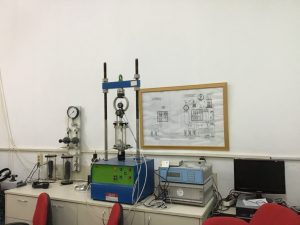Laboratory Manager : Dr. Sachpazis Konstantinos, Professor
Professor of Geotechnical Engineering, e-mail: csacpazis@uowm.gr and costas@sachpazis.info
Purpose
The Laboratory of Geotechnical Engineering is equipped with modern facilities to support undergraduate and postgraduate studies in the field of Geotechnical Engineering.
Facilities
Conventional laboratory equipment, including odometer, direct shear test, triaxial test, laboratory vane shear test, fixed hydraulic load and hydraulic load drop gauge, Proctor condensation test and test equipment (CBR).
Field Sampling and Monitoring Equipment (eg Manual Drilling Equipment, MASW system).
Laboratory tests
Based on the available laboratory equipment, the following tests are performed on Soils and Rocks:
Soils
- Direct Shear UU, CU
- Slow Shear CD
- Unobstructed or Uniaxial Compression Test
- Double hydrometer test
- Compression and CBR Control
- Solidification test
- Proctor Condensation Test
- Free Swelling / Swelling Tests
- Soil Suction Test
- Granular Analysis (sieves, diluent)
- One-dimensional & three-dimensional solidification
- Blade shear test
- Limits Atterberg
- Determination of organic, pH & CaCOM3
- Triaxial Compression Test UU, CU, CUPP, CD (1.5 ”, 4”, 6 ”)
- Water permeability of Saturated Soils
- Hydraulic Conductivity Test (on site)
- Apparent Field Density Test
- Apparent Density
Rocks
- Resistance to Discontinuous Shear
- Brazilian Test
- PLT Point Charging Index
- Hardness Index
- Jar Slake Test
- Corrosion control
- Ultrasound Test for Poisson Speech Determination
- Uniaxial Grief
- Uniaxial Compression By measuring Elastic Parameters
- Petrographic Analysis
- Density & Porosity
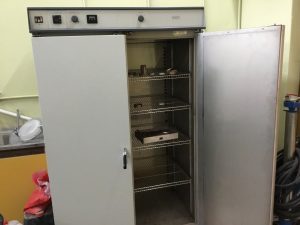
The laboratory part of the courses aims to provide the necessary knowledge to undergraduate and postgraduate students in matters related to research and studies of Geotechnical Engineering (Soil Engineering and Rock Engineering), so that students can understand and respond to this subject.
- Understand the parameters and characteristics of soil and rock that affect their composition, physical and mechanical behavior.
- To carry out laboratory and field tests to determine the soil and rock mechanical parameters and characteristics, and the correct use of soil and rock, both as a construction material for construction projects, as a material for receiving loads of technical works and for geomechanical stability; and their security.
- To organize and perform laboratory tests to determine soil and rock characteristics and parameters.
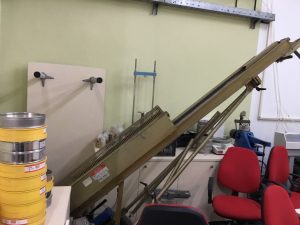
The following laboratory equipment is indicated:
Α / Α LABORATORY DEVICE / INSTRUMENT
1 RMU I odometer
2 Electromagnetic sieve vibrator CONTROLS D-407
3 Series of 9 sieves for RMU particle size analysis
4 CISA metal sieves
5 Manual compression machine 2KN, ELE, Serial No 206-6
6 Electric compression machine 2KN, ELE, Serial No 206-6
7 Chyo Electromagnetic Scale, MP-6000, SN 75421
8 Mechanical scale 15 Kg, fd THORNTON & COLT
9 Mechanical scale 100 Kg weylux, model 150
10 Mechanical scale 50 Kg ELE
11 Dryer 1000 lit, EHRET TK1, No. 20098
12 Starrett digital caliper, No722
13 Electric mixer 10 L, CONTROLS, SN 95304
14 Sand equivalent device, RMU, Sr 583 accompanied by a shaker RMU 5019
15 Paraffin melting device for the determination of apparent weight, MEPAX, type 47511, SN 54006
16 Rapid ground moisture measuring device, Riedel-de-Haen, type CM-Great
17 Dynamic pedometer RMU, SI 70, accompanied by motorized rod lifting device RMU I 65/1
18 PROCTOR device, standard CONTROLS method
19 PROCTOR device, modified standard CONTROLS method
20 EHPET sample dryer, SN 20093
21 Ph-METRO HANNA, type HI 9025C
22 Water limitation device, CASAGRANDE, manual RMU S1
23 Pocket pedometer (Pocket) RMU
24 PROCTOR – Πενετρόμετρο RMU, SN 39-02-92
25 Plasticity limiting set
26 Air compressor 100 lit, TOROS
27 On-site CBR detector, CONTROLS T115 / A
28 Three-axle test machine RNU, S 102, capacity 50KN accompanied by:
- RMU S 116 triaxial cell for 38.1 x 76.2 samples
- Air pressure to water pressure conversion cells 1000 KPa
- Volume change device
- Manometer
- MPX-2000 geotechnical data collection and processing system
- Digital longitudinal symmeters
29 PC Z 840 PC
30 HP Desk Jet 5100 Printer
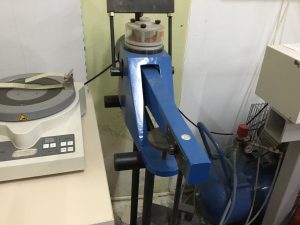
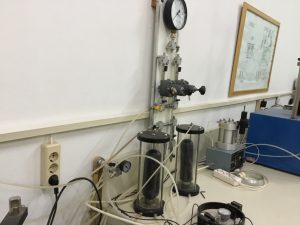
Indicative Presentations / Lectures on Geotechnical Engineering:
![]() Soil Classification (In Greek)
Soil Classification (In Greek)
![]() Shear strength of soils (In Greek)
Shear strength of soils (In Greek)
![]() Introduction to Geotechnical Engineering (In Greek)
Introduction to Geotechnical Engineering (In Greek)
Indicative Professional Presentations in Geotechnical Engineering:
![]() Geodomisi Ltd.-Article in the Periodical Greek Structures, Published on No 124 Bulletin (in Greek)
Geodomisi Ltd.-Article in the Periodical Greek Structures, Published on No 124 Bulletin (in Greek)![]() «Anchored Earth Retaining Structures» Construction Procedure Presentation of anchored steel piled retaining systems – Berlinoise (in Greek)
«Anchored Earth Retaining Structures» Construction Procedure Presentation of anchored steel piled retaining systems – Berlinoise (in Greek)![]() Deep Excavation supported by Anchored Reinforced Pile Retaining Wall in Aigiptou Square, Alexandras Avenue, Athens, Greece
Deep Excavation supported by Anchored Reinforced Pile Retaining Wall in Aigiptou Square, Alexandras Avenue, Athens, Greece
![]() Lateral Earth Pressures (in Greek)
Lateral Earth Pressures (in Greek)
![]() Technical Note on Application of Ground Penetrating Radar (GPR) to Archaeological Site Characterization
Technical Note on Application of Ground Penetrating Radar (GPR) to Archaeological Site Characterization
![]() Foundation Pile Bearing Capacity Analysis / Verification
Foundation Pile Bearing Capacity Analysis / Verification
![]() Capabilities and Qualifications Onshore Geophysical and Geological Engineering Investigation and Survey Services
Capabilities and Qualifications Onshore Geophysical and Geological Engineering Investigation and Survey Services![]() Which areas in Attica district, Greece are in the dyne of floods (in Greek)
Which areas in Attica district, Greece are in the dyne of floods (in Greek)
![]() Geotechnical Engineering Site Investigation and Characterisation Procedure (in Greek)
Geotechnical Engineering Site Investigation and Characterisation Procedure (in Greek)
